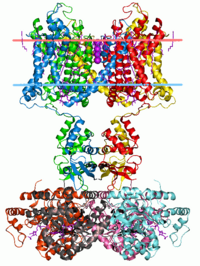
Photo from wikipedia
Voltage-gated sodium (Na+) channels respond to short membrane depolarization with conformational changes leading to pore opening, Na+ influx, and action potential (AP) upstroke. In the present study, we coupled channelrhodopsin-2… Click to show full abstract
Voltage-gated sodium (Na+) channels respond to short membrane depolarization with conformational changes leading to pore opening, Na+ influx, and action potential (AP) upstroke. In the present study, we coupled channelrhodopsin-2 (ChR2), the key ion channel in optogenetics, directly to the cardiac voltage-gated Na+ channel (Nav1.5). Fusion constructs were expressed in Xenopus laevis oocytes, and electrophysiological recordings were performed by the two-microelectrode technique. Heteromeric channels retained both typical Nav1.5 kinetics and light-sensitive ChR2 properties. Switching to the current-clamp mode and applying short blue-light pulses resulted either in subthreshold depolarization or in a rapid change of membrane polarity typically seen in APs of excitable cells. To study the effect of individual K+ channels on the AP shape, we co-expressed either Kv1.2 or hERG with one of the Nav1.5-ChR2 fusions. As expected, both delayed rectifier K+ channels shortened AP duration significantly. Kv1.2 currents remarkably accelerated initial repolarization, whereas hERG channel activity efficiently restored the resting membrane potential. Finally, we investigated the effect of the LQT3 deletion mutant ΔKPQ on the AP shape and noticed an extremely prolonged AP duration that was directly correlated to the size of the non-inactivating Na+ current fraction. In conclusion, coupling of ChR2 to a voltage-gated Na+ channel generates optical switches that are useful for studying the effect of individual ion channels on the AP shape. Moreover, our novel optogenetic approach provides the potential for an application in pharmacology and optogenetic tissue-engineering.
Journal Title: Membranes
Year Published: 2022
Link to full text (if available)
Share on Social Media: Sign Up to like & get
recommendations!